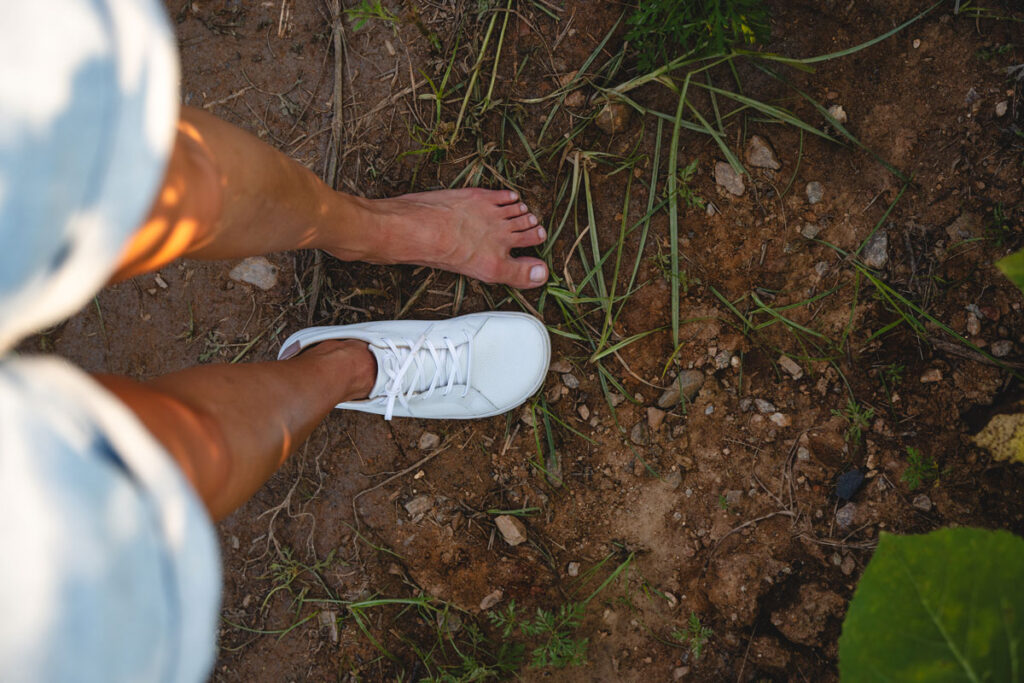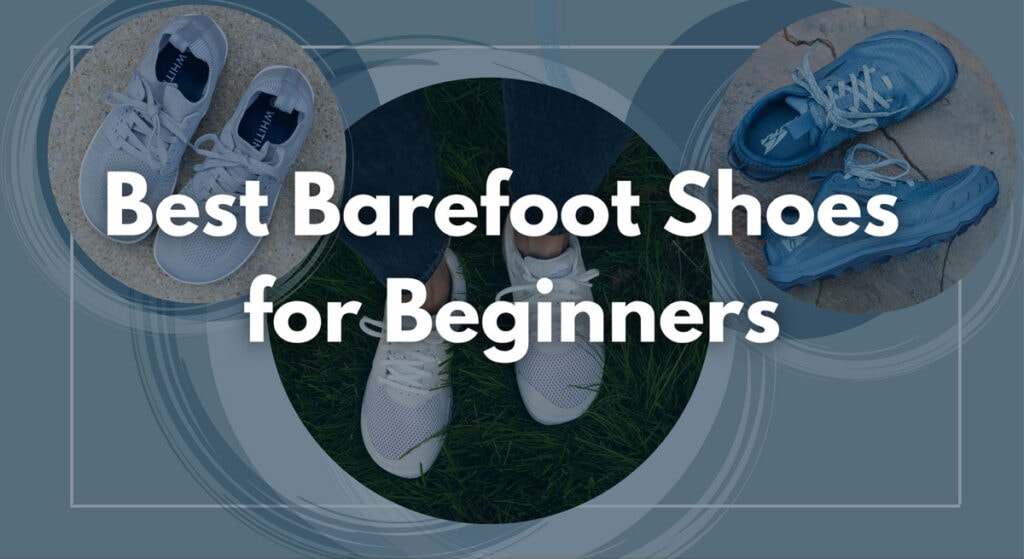How to Transition to Barefoot Shoes: A Simple Guide for the Barefoot Shoe Beginner

As your Barefoot Shoe Guide, I’m here to help. In this post, I’ll walk you through how to transition to barefoot shoes to start on the path towards healthier, happier feet.
If you’re new to the world of barefoot shoes, then welcome! Maybe you just thought you’d start looking for more comfortable shoes, and all of a sudden you found yourself questioning all the footwear rules you grew up with, learning a bunch of new terms you’ve never heard of, and completely rethinking all of your footwear choices. It can be a lot!
This article is meant outline the steps to help you transition to barefoot shoes and get on the path to healthier feet.
You don’t have to clean out your whole shoe closet in one go and buy all new shoes today. Once you start diving into the world of barefoot shoes and foot health, you’ll find that there is a lot of stuff that can go along with it that is incredibly helpful. But it can also be expensive and overwhelming. If you just want to start with the basics, then this simple guide is for you.
Read Frequently Asked Questions about barefoot shoes here.
Note: This post may contain affiliate links. This means if you click on one of them, we may receive a small commission at no additional cost to you. Thank you for your support!

Simple tips to transition to barefoot shoes
1 Go barefoot as much as possible
So, you’ve just heard about barefoot shoes? But you’re probably wondering, how do you actually start that transition to minimalist shoes. A first easy (and free!) step is to go barefoot as much as possible. Stay barefoot at home and when you’re walking around your yard. Basically, just let your feet be free to move naturally whenever you can. This will help strengthen your feet, especially as you expose them to more variability in textures and terrain. It’s just like any other muscles in your body – they need to work to grow.
2 Switch out the shoes you wear most to barefoot or minimalist shoes
Making this healthy lifestyle change for your feet and your body isn’t all or nothing, but you’re going to see the most benefit the more you opt for healthy footwear. And if you’re like me, you might not want to wear conventional shoes again as you realize just how uncomfortable and problematic they are.
The term barefoot shoe is to reflect the fact that the shoes honor the natural foot shape and let us walk and move similarly to how we do when barefoot. It doesn’t mean you can’t wear them with socks, which is a question I get a lot. Just make sure your socks also reflect your natural foot shape, so either toe socks or ones with a wider toe box (find some sock options here).
Start slow and listen to your body. Transitioning to barefoot shoes is a full body adjustment, and it can take time.
When I say barefoot shoes or minimalist shoes, this is what to look for:
- Wide, anatomically-shaped toe box: Your shoes should reflect your foot’s natural shape
- Flat, or zero-drop sole: This lets our body stand flat on the ground as opposed to constantly standing on an incline with our heel’s elevated.
- Flexible: Both the sole and the uppers should be flexible to allow for natural movement. The soles should be flexible overall, not just at the ball of the foot.
- Thin: A shoe with a thin sole is more flexible, and also affords our feet better ground feel, connection to our environment, and the ability for natural movement. This is often one of the harder aspects for people to adjust to when switching to barefoot shoes. And it’s no surprise if you take a look at most conventional shoes, they have so much cushion! If you need a thicker sole while transitioning, there are several brands that have a bit more cushion than the most minimal barefoot shoes.

3 Do some background reading about how our shoes and feet impact our body
This is optional, but it helps to see the bigger picture and have a fuller understanding of why barefoot shoes are better for our body. I highly recommend the book Whole Body Barefoot: Transitioning Well to Minimal Footwear by biomechanist Katy Bowman.
4 Start strengthening your feet with simple foot exercises
The cushion, support and lack of space for my feet and toes to move properly while in my old conventional shoes meant my foot strength and function wasn’t great when I discovered barefoot shoes. Besides just wearing barefoot shoes, it took some effort and exercises to restore that lost functionality in my feet and toes.
These are a good set of exercises to start with.
I’ve also found online courses that are very helpful in guiding you through the foot exercises and helping you level up. I recommend this Fix Your Feet course for beginners by My Foot Function to start with. The course costs $43 and you can use code KELLY10 for 10% off. My Foot Function also offers a starter package that includes several workshops along with tools like toe separators and training bands that you can use for a lot of different exercises.

5 Check your gait
Walking is something most of us don’t even think about anymore, but we have gait patterns that are influenced by the shoes we wear. If you’ve been wearing shoes with a heel-drop and heavily cushioned soles, you may be doing things like striking the ground harder than you realize and adjusting your body to compensate for the elevated heel.
Switching to barefoot shoes can be a wake-up call as you can feel a whole lot more of how you’re interacting with the ground beneath you. This Harvard Health article has a few tips on how to transition to barefoot walking, whether that’s completely barefoot or in barefoot shoes.
And remember to walk before you run – if you are planning on running in barefoot shoes, make sure you are fully transitioned to barefoot shoes for your everyday shoes first. Vivobarefoot offers a great online course that teaches proper technique for running in barefoot shoes and includes personal feedback from their running coaches.
6 Assess where you’re starting from and transition at your own pace
When considering how to transition to minimalist shoes, it important to remember we all have unique feet, bodies and life experiences, so everyone’s path to healthy feet is different. Some people may find the transition to zero drop shoes with minimal cushion easy. Others may have a harder time adjusting based on changes their body has made to adapt to shoes, or injuries they are dealing with.
Whatever your starting point, go at your own pace. Listen to your body (and feet), and take it as slowly as you need to.
If you do have chronic pain associated with your feet, consider consulting with a medical professional that focuses on naturally restoring foot function. If you’ve had a few medical visit and gotten the standard line of orthotics or surgery, I understand if you’re wary of seeing yet another person. While orthotics may be an interim solution and surgery for some people might be necessary, these options seem to be recommended far too often (and cost a lot of money).
If you have chronic pain, it is better to understand and treat the underlying issue before starting your transition to barefoot shoes. Getting a gait analysis can be a good place to start understand how you are moving and what changes need to be made for healthy, functional movement.
There is a group called the Healthy Feet Alliance of health professionals that believes your feet can be healthy, strong and support themselves, and are focused on your long-term foot health – you can read their manifesto here. Many of these health professionals provide virtual consultations. You can see the full list here.
A few barefoot shoes to get started
One thing you’ll quickly see when you start shopping for barefoot shoes is that it can be overwhelming and pretty expensive. Here’s a short list of brands to check out to get you started.
Lems Shoes: I often recommend Lems to those that are new to barefoot shoes as they have great style, but a bit more cushion compared to some of the most minimal barefoot shoes. They also have a really roomy toe box for the widest styles.
Whitin Shoes on Amazon, $42 : Amazon has several different cheap barefoot shoe brands. I think Whitin shoes are some of the best ones for the price, and since it’s Amazon, they can be easily returned if they don’t fit. The toe box on Whitin Wide Barefoot Shoes are pretty roomy and the sole is flexible. They have a sporty tennis shoe and a casual shoe option. At around $40, Whitins are a really affordable barefoot shoe option that look good and are reasonably durable. Just make sure you’re looking at their wide barefoot tab. Joomra Shoes is another similar brand on Amazon that is very affordable.
Sandals: If you’re a sandal kind of person, swapping out your flip flops or sandals with little heels for something that securely attaches to your foot and has a flat, flexible sole can be a pretty easy switch. Here are a few sandal brands to check out:
- Earth Runners: I recommend opting for the softer lifestyle laces. Use code KELLY10 for 10% off
- Luna Sandals
- Xero Shoes Z-Trails: These are a great option if you don’t like a strap between your toes

Find my top recommendations for the best barefoot shoes for beginners.
To wrap up
Transitioning to barefoot shoes has had an overwhelmingly positive impact on my life. Comfortable, foot-shaped shoes now seem like such an obvious thing to me, but I know many people never consider that their shoes are causing so many problems in their feet and body (I was one of them before). If you’re on the fence about barefoot shoes, just give them a try!
I hope this helps with your transition to barefoot shoes. Let me know if you have any questions below!







7 Comments